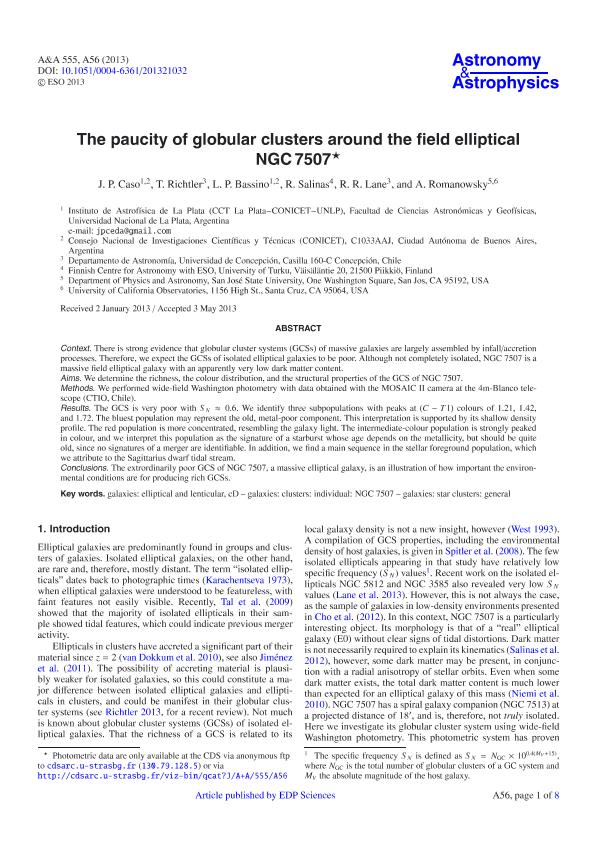Mostrar el registro sencillo del ítem
dc.contributor.author
Caso, Juan Pablo

dc.contributor.author
Richtler, Tom
dc.contributor.author
Bassino, Lilia Patricia

dc.contributor.author
Salinas, R.
dc.contributor.author
Lane, R. R.
dc.contributor.author
Romanowsky, A.
dc.date.available
2017-01-03T14:52:59Z
dc.date.issued
2013-07
dc.identifier.citation
Caso, Juan Pablo; Richtler, Tom ; Bassino, Lilia Patricia; Salinas, R.; Lane, R. R.; et al.; The paucity of globular clusters around the field elliptical NGC 7507; Edp Sciences; Astronomy And Astrophysics; 555; 7-2013; 56-64
dc.identifier.issn
0004-6361
dc.identifier.uri
http://hdl.handle.net/11336/10734
dc.description.abstract
Context. There is strong evidence that globular cluster systems (GCSs) of massive galaxies are largely assembled by infall/accretion processes. Therefore, we expect the GCSs of isolated elliptical galaxies to be poor. Although not completely isolated, NGC 7507 is a massive field elliptical galaxy with an apparently very low dark matter content.
Aims. We determine the richness, the colour distribution, and the structural properties of the GCS of NGC 7507.
Methods. We performed wide-field Washington photometry with data obtained with the MOSAIC II camera at the 4m-Blanco telescope (CTIO, Chile).
Results. The GCS is very poor with SN ≈ 0.6. We identify three subpopulations with peaks at (C − T1) colours of 1.21, 1.42, and 1.72. The bluest population may represent the old, metal-poor component. This interpretation is supported by its shallow density profile. The red population is more concentrated, resembling the galaxy light. The intermediate-colour population is strongly peaked in colour, and we interpret this population as the signature of a starburst whose age depends on the metallicity, but should be quite old, since no signatures of a merger are identifiable. In addition, we find a main sequence in the stellar foreground population, which we attribute to the Sagittarius dwarf tidal stream.
Conclusions. The extrordinarily poor GCS of NGC 7507, a massive elliptical galaxy, is an illustration of how important the environmental conditions are for producing rich GCSs.
dc.format
application/pdf
dc.language.iso
eng
dc.publisher
Edp Sciences

dc.rights
info:eu-repo/semantics/openAccess
dc.rights.uri
https://creativecommons.org/licenses/by/2.5/ar/
dc.subject
Ngc 7507 (Galaxia)
dc.subject
Eliptical Galaxies
dc.subject
Lenticulars Galaxies
dc.subject
Clusters of Galaxies
dc.subject.classification
Astronomía

dc.subject.classification
Ciencias Físicas

dc.subject.classification
CIENCIAS NATURALES Y EXACTAS

dc.title
The paucity of globular clusters around the field elliptical NGC 7507
dc.type
info:eu-repo/semantics/article
dc.type
info:ar-repo/semantics/artículo
dc.type
info:eu-repo/semantics/publishedVersion
dc.date.updated
2016-11-18T15:11:08Z
dc.journal.volume
555
dc.journal.pagination
56-64
dc.journal.pais
Francia

dc.journal.ciudad
Paris
dc.description.fil
Fil: Caso, Juan Pablo. Consejo Nacional de Investigaciones Científicas y Técnicas. Centro Científico Tecnológico la Plata. Instituto de Astrofísica de la Plata; Argentina. Universidad Nacional de La Plata; Argentina
dc.description.fil
Fil: Richtler, Tom . Universidad de Concepción; Chile
dc.description.fil
Fil: Bassino, Lilia Patricia. Consejo Nacional de Investigaciones Científicas y Técnicas. Centro Científico Tecnológico la Plata. Instituto de Astrofísica de la Plata; Argentina. Universidad Nacional de La Plata; Argentina
dc.description.fil
Fil: Salinas, R.. University of Turku. Finnish Centre for Astronomy with ESO ; Finlandia
dc.description.fil
Fil: Lane, R. R.. Universidad de Concepción; Chile
dc.description.fil
Fil: Romanowsky, A. . University of California Observatories; Estados Unidos. San José State University; Estados Unidos
dc.journal.title
Astronomy And Astrophysics

dc.relation.alternativeid
info:eu-repo/semantics/altIdentifier/doi/http://dx.doi.org/10.1051/0004-6361/201321032
dc.relation.alternativeid
info:eu-repo/semantics/altIdentifier/url/http://www.aanda.org/articles/aa/abs/2013/07/aa21032-13/aa21032-13.html
Archivos asociados
